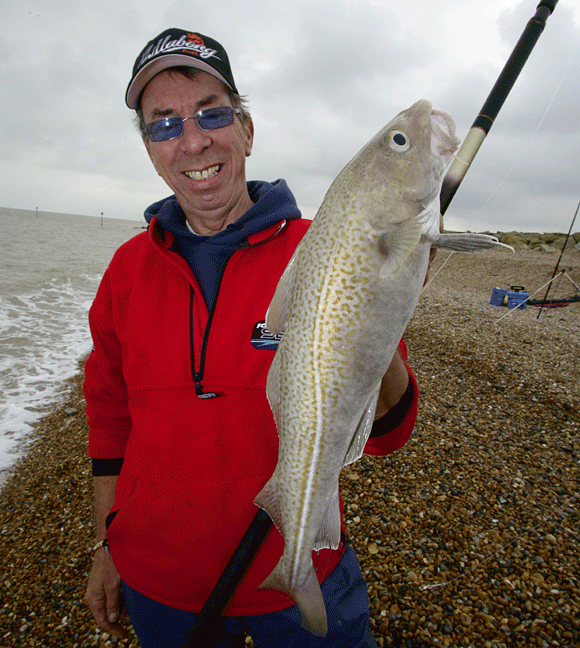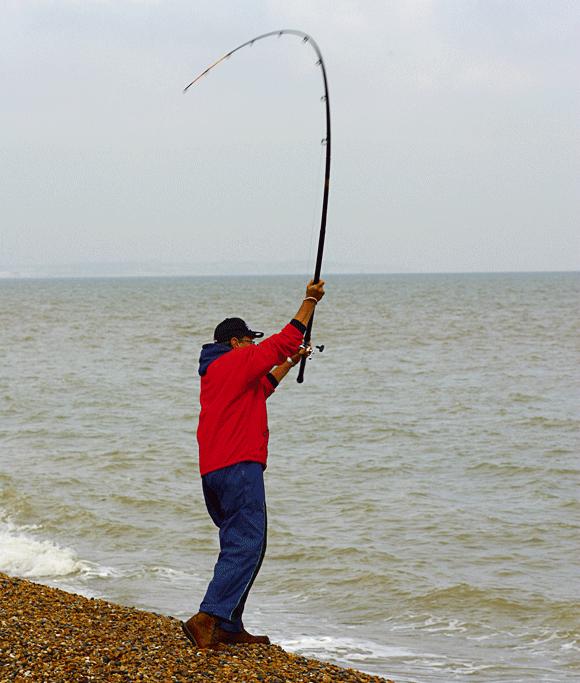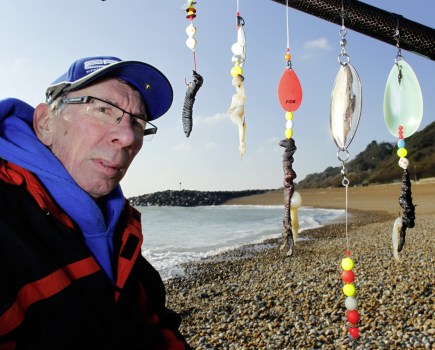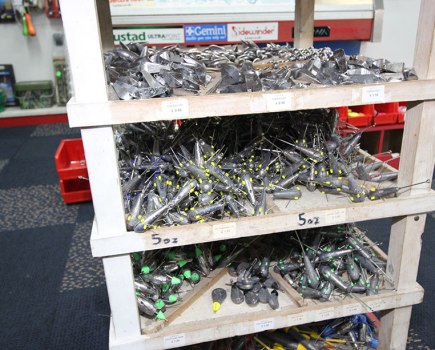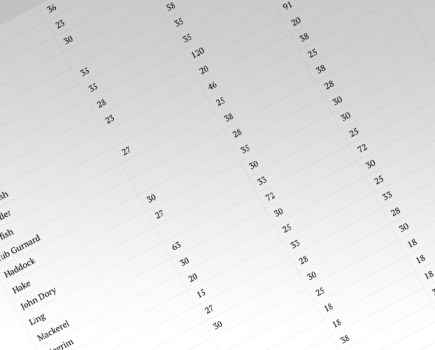Make no mistake – fishing for cod is one of the most difficult branches of shore angling to attempt.
It’s mostly because in recent years cod have been scarce. The species is rarely found really close to the shore, and almost invariably a decent cast is required to reach feeding fish.
There is a saying that all the cod caught are hooked by a third of anglers fishing, and this is because casting is such an important element of cod fishing. A basic standard of casting ability and some local knowledge is essential, so cod are not the starting point for the novice sea angler.
So, if you are a total beginner, before you turn your attention to catching cod it is advisable to learn the basic shore angling skills first. Priorities to focus on include obtaining suitable tackle, learning to cast and understanding your local venues.
Joining an angling club and fishing in events is an effective way of learning basic shore angling skills.
During winter the weather conditions add to the difficulty of casting far enough to reach the fish and keeping a bait out there, so your choice of venue becomes of major importance. Dashing off to the hottest cod beach is pointless if your casting skill and range does not allow you to pass the breakers. So you will first have to consider venues where distance is less of a priority. Rock marks and piers are the best choice, because they offer easier access to deep water and the fish. If you don’t consider piers or rocks, then get some casting lessons.
The next problem to overcome is imagination. Lots of sea anglers allow themselves to be carried away by the excitement of it all. Rumours are part and parcel of the winter cod season, and a large number of anglers are totally screwed by their imagination. You will get better results if you can resist the temptation to believe everything you hear and just stick to facts and logic.
Staying realistic may not be easy…
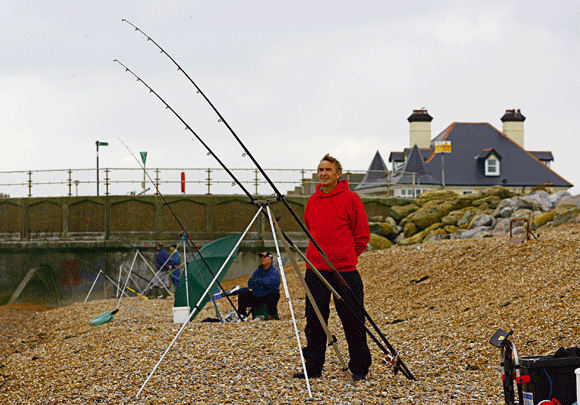
It is important to choose a venue that suits your casting ability.
FACTS – GOOD AND BAD
1. A strong onshore wind (gale) can exaggerate the difficulties of catching fish from the shore, so be realistic about your abilities when you arrive at a venue. Will you be able to fish effectively? If not, move to a venue where you can. Are conditions as bad as they appear? Get out of the car and watch the sea for a few minutes before abandoning a venue.
2. A cod is not a cod until it grows to around 6lb. Prior to that it is called a codling or a Tommy cod, although in many regions all codling are called cod. Cod caught by shore anglers are usually codling, often less than 3lb.
3. Cod are a shoal species, but as individual fish grow, the number in the shoal decreases. Once a codling reaches 3lb, it is big enough to be trapped by the commercial gill net mesh and that’s when a dramatic decrease in numbers occurs.
4. As a cod grows bigger, its food intake increases and it switches to a fish diet and moves offshore. When there are lots of cod, an overspill of the bigger fish reaches the shoreline.
5. Size of fish is often exaggerated by anglers.
6. Lucky anglers are very often those who have made the most effort for success. That may seem like bad news to some, but now for the good news. In lots of regions of the UK codling are being caught in numbers from known venues. These are the places to fish, so do some research and be prepared to travel or walk to a productive spot.
7. Best time to target the fish is at night because, like most fish, cod venture closer to the shore in darkness because they feel more secure, as do the small fish that they eat. In daylight the sun penetrates the sea and this deters fish from entering the shallows. Fishing at night increases your chances of catching a cod, I would say, by 100 per cent, depending upon region and venue. That apart, you are also likely to catch more whiting and other species because they, too, prefer darkness to daylight for travelling inshore. If you are limited to fishing in daylight, look for venues with rough and coloured water because this encourages fish inshore.
8. The best time to fish for codling on most venues is obviously when they are present, but the state of the tide affects this. A majority of venues produce codling during the strongest spring high tides, because fish and fish food activity are at their greatest. However, the strongest spring high and low tides can make some venues difficult to fish, and these are best tackled during the less powerful neap tides. The fish use the flood and ebb tides to travel to and from a supply of food. Slack water periods are rarely very productive, but again there are exceptions. This is why local knowledge as to where and when cod are present is so important. It can be learned, and is consistent.
9. The weather plays its part and, in general, an onshore wind and a coloured sea will be most productive in daylight. A calm, clear sea with an offshore wind is best at night.
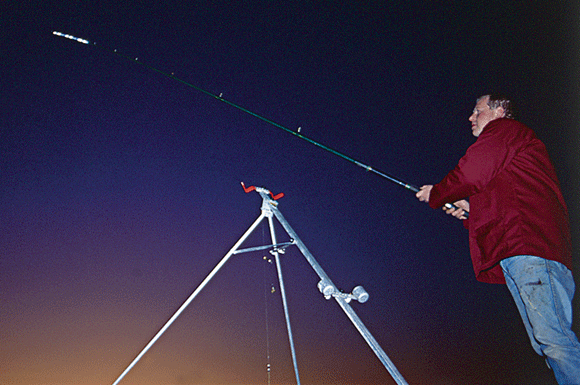
Fishing at night is usually more productive for cod.
TACKLE AND BAIT
Thanks to the Far East, our fishing tackle is no longer expensive, and, although quality is totally controlled by price, the most basic tackle will enable you to fish, allbeit at a starter level.
You can purchase a rod and reel for as little as £50, but this will offer limited casting range and durability. Spending £150 on a better quality outfit is a better option if you are serious about taking up shore angling. The cost does not end there, because all the other tackle will cost as much, if not more, than your rod and reel.
Basic shore tackle, suitable for cod and other species, includes a beachcaster 12ft to 15ft in length, rated to cast between 5oz and 8oz. A wide range of rod lengths and casting ratings are available, and most novice buyers will benefit from advice from a dealer or an experienced angler.
Two types of reel are used for shore fishing – the fixed-spool and the multiplier. The former is the easier of the two for the beginner to operate because its spool does not spin, so there is less risk of an overrun and line tangles.
Tackle for fishing from a clean shore (no rocks) involves the use of line of 12-18lb breaking strain (0.33mm-0.38mm diameter) and a lead weight of 5-6oz (150-175g), so your reel needs to be of a suitable size and capacity to make it capable of maximum distance casts with this combination. Heavier line (25-30lb) and a larger capacity reel is required for rough ground. Line as light as 15lb breaking strain will not cast a 5oz-plus lead weight safely, so a short (two-rod) length of stronger line called a shockleader (60lb/0.70mm) is essential to take the strain of casting.
Other required items include a seat/tackle box to sit on and store your spare gear in the dry, as well as warm waterproof clothing and a tripod to position your rod. The latter can be invaluable to position the rod tip high above the waves and prevent wind and swell hitting the line or gathering weed. You will require a headlamp if fishing after dark.
Various accessories are needed, such as terminal tackle, a knife, scissors, bait cotton, spare line, hooks, links and swivels. Terminal gear includes a selection of rigs in a rig wallet, plus lead weights, both breakout and fixed wired, to combat strong tide and wind.
Rigs can be complicated, but the simplest is the one-hook monofilament paternoster, and most tackle dealers will have these in a range of hook sizes.
The novice can buy ready-made rigs and then copy them.
Hooks between size 1 and 6/0 are the most suitable for shore cod fishing, depending on the size of the bait and the fish targeted. Long-shank Aberdeen hooks in size 1 to 3/0 are suitable for baiting with lugworms, and the larger patterns for whole squid or crab baits. In general one large bait is often preferred for cod, and a Pennell rig is favourite. The Pennell has two hooks on a single hooklength, with a hook placed at each end of the bait.
Best baits are lugworms, squid and peeler crabs, although other baits catch codling in some regions but are not so effective countrywide. ‘A large bait for a big fish’ holds true for cod because it helps prevent small nuisance fish taking your offering.
It is not unusual to catch a big fish on a small bait aimed at whiting and dabs.
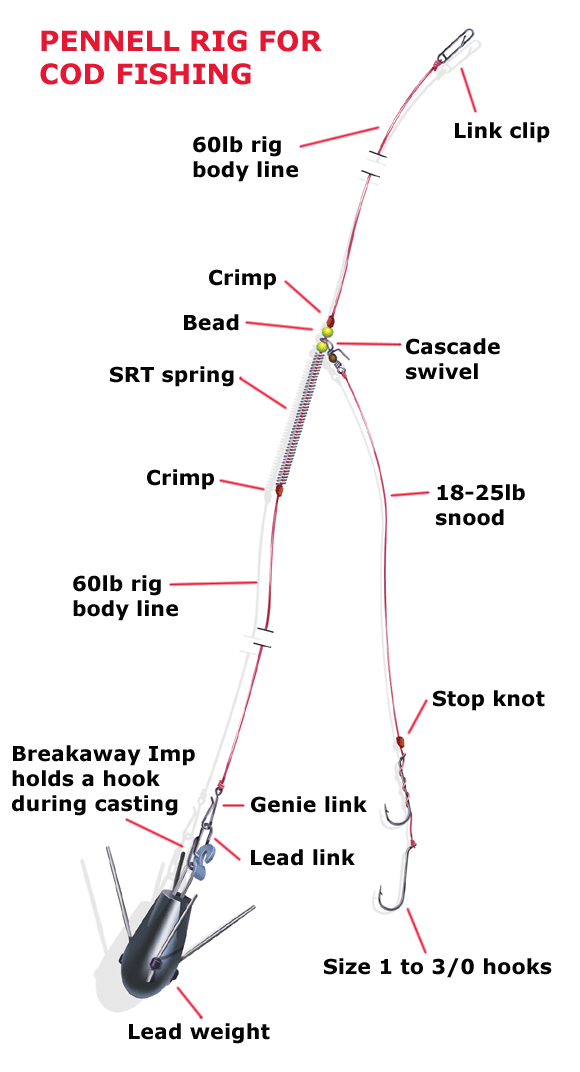
Beginners to cod fishing from the beach or shore will do well using a straightforward Pennell rig,
just like the one pictured above. Using a Breakaway Imp will help streamline the rig
and bait and therefore help you cast much further.
TOP COD TACTICS
1 Being in the right place at the right time is how to catch cod. You can fish for marathon periods to be sure you are fishing when the cod arrive, or you can target venues at the peak weather, tides and times. It is not an exact science, but it is more productive than fishing without any regard to tides and weather.
2 Obtaining a supply of lugworms in winter is not easy, especially when the cod are around, because demand is greater, daylight shorter and the weather bad, making worms scarce. Dealer loyalty will help you obtain a regular supply of fresh lugworms. Failing that, you can keep a supply of frozen baits, such as calamari squid, peeler crabs, shellfish, black lug and farmed prawns – they’re not so good as fresh lugworm, but they will get you fishing.
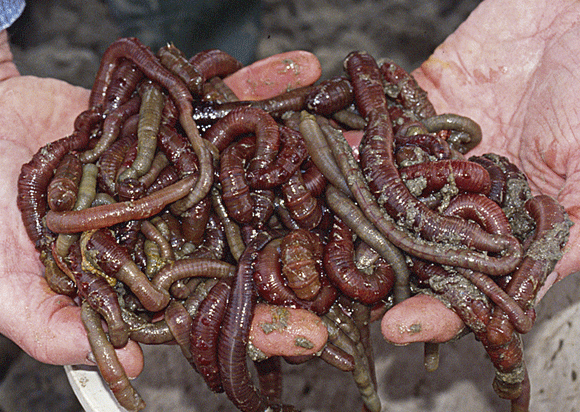
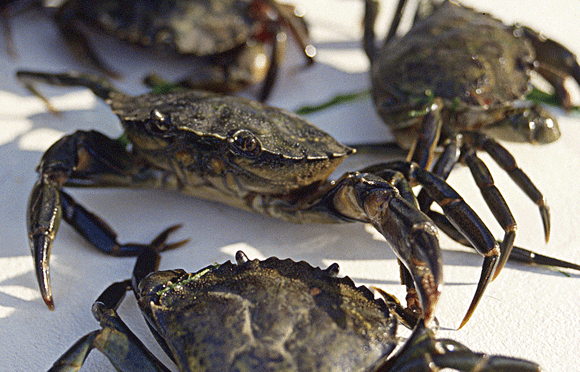
Top baits for cod include lugworms…
and good old, reliable peeler crabs.
3 With casting range critical, balanced tackle is essential in terms of the mainline diameter, the casting weight, bait size and terminal tackle streamlining. Large hookbaits will cut down on casting distance. Rigs incorporating a bait clip device will cast further than those without, simply because a bait flapping around will slow the lead weight’s speed. Pinned close behind the lead weight, a bait is less of a hindrance and will cast further.
Heavier lead weights of 6oz and 7oz can improve your casting into a head wind, sink quicker and hold the bottom far more effectively.
4 Once cast, a bait leaks scent and juices into the water and, hopefully, fish will home in on the scent trail. The size of your bait and the timing of each cast is important in terms of maximising the bait’s potential. Retrieving too soon or leaving your bait out too long, so it becomes washed out or eaten by crabs, effectively reduces the likelihood of a catch. Renew your bait completely every cast, because recasting a washed-out bait is the most common mistake of the novice cod angler.
5 Using two rods increases the odds of a catch. You can also fish at two different ranges with different baits. Other options to make your session more active include using a second rod armed with either a livebait rig for a big fish or multi-hook rig for smaller species. Remember, fishing just for a big cod with a big bait can be very slow on occasions.
6 Cod bites are usually positive, and sometimes you have very little alternative to striking as your rod is pulled off the rod-rest. However, slack line bites are notoriously difficult to hook. In all cases, taking your time when confronted with a bite will improve your chances of hooking a fish.
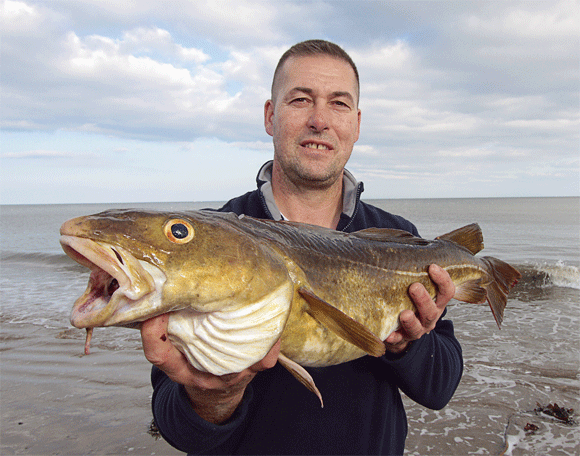
Most cod caught by shore anglers will weigh less than 3lb.
COD FISHING BASICS
You do not require a licence to fish for sea fish from the shore. You can fish from almost any shore venues, but exceptions include MoD firing ranges, HM Customs-controlled areas and docks. There are few private beaches.
There are no laws governing tackle, so you can use as many rods as you wish and as many hooks. Most anglers prefer two rods and a maximum of three hooks per rod, but cod fishing is often done with one bait held by two hooks, called a Pennell rig.
UK law determines the size of the fish you can remove from the sea, with legal minimum sizes for lots of species set by DEFRA and the local sea fisheries committees. The minimum size at which you can remove and kill a cod from the sea is 35cm. This is not just for competition anglers. Measured from nose to tail, fish under this size must be returned. Keeping undersized fish is against UK law and carries a considerable fine.
What is a realistic target for the cod angler? Much depends upon where you live and fish, but a double-figure cod from the shore is a prize indeed.
It is a fact that the odd large fish that is dying is often caught from the shore. Called a ‘slink’ among other local names diseased and emaciated cod are not suitable for eating, so check your fish over before taking it for the table.
